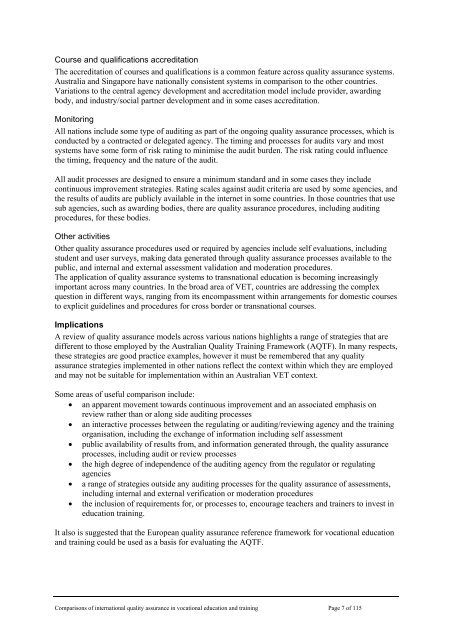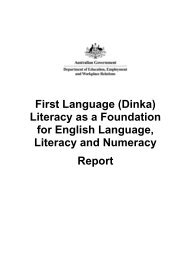Review - Department of Innovation, Industry, Science and Research
Review - Department of Innovation, Industry, Science and Research
Review - Department of Innovation, Industry, Science and Research
You also want an ePaper? Increase the reach of your titles
YUMPU automatically turns print PDFs into web optimized ePapers that Google loves.
Course <strong>and</strong> qualifications accreditation<br />
The accreditation <strong>of</strong> courses <strong>and</strong> qualifications is a common feature across quality assurance systems.<br />
Australia <strong>and</strong> Singapore have nationally consistent systems in comparison to the other countries.<br />
Variations to the central agency development <strong>and</strong> accreditation model include provider, awarding<br />
body, <strong>and</strong> industry/social partner development <strong>and</strong> in some cases accreditation.<br />
Monitoring<br />
All nations include some type <strong>of</strong> auditing as part <strong>of</strong> the ongoing quality assurance processes, which is<br />
conducted by a contracted or delegated agency. The timing <strong>and</strong> processes for audits vary <strong>and</strong> most<br />
systems have some form <strong>of</strong> risk rating to minimise the audit burden. The risk rating could influence<br />
the timing, frequency <strong>and</strong> the nature <strong>of</strong> the audit.<br />
All audit processes are designed to ensure a minimum st<strong>and</strong>ard <strong>and</strong> in some cases they include<br />
continuous improvement strategies. Rating scales against audit criteria are used by some agencies, <strong>and</strong><br />
the results <strong>of</strong> audits are publicly available in the internet in some countries. In those countries that use<br />
sub agencies, such as awarding bodies, there are quality assurance procedures, including auditing<br />
procedures, for these bodies.<br />
Other activities<br />
Other quality assurance procedures used or required by agencies include self evaluations, including<br />
student <strong>and</strong> user surveys, making data generated through quality assurance processes available to the<br />
public, <strong>and</strong> internal <strong>and</strong> external assessment validation <strong>and</strong> moderation procedures.<br />
The application <strong>of</strong> quality assurance systems to transnational education is becoming increasingly<br />
important across many countries. In the broad area <strong>of</strong> VET, countries are addressing the complex<br />
question in different ways, ranging from its encompassment within arrangements for domestic courses<br />
to explicit guidelines <strong>and</strong> procedures for cross border or transnational courses.<br />
Implications<br />
A review <strong>of</strong> quality assurance models across various nations highlights a range <strong>of</strong> strategies that are<br />
different to those employed by the Australian Quality Training Framework (AQTF). In many respects,<br />
these strategies are good practice examples, however it must be remembered that any quality<br />
assurance strategies implemented in other nations reflect the context within which they are employed<br />
<strong>and</strong> may not be suitable for implementation within an Australian VET context.<br />
Some areas <strong>of</strong> useful comparison include:<br />
• an apparent movement towards continuous improvement <strong>and</strong> an associated emphasis on<br />
review rather than or along side auditing processes<br />
• an interactive processes between the regulating or auditing/reviewing agency <strong>and</strong> the training<br />
organisation, including the exchange <strong>of</strong> information including self assessment<br />
• public availability <strong>of</strong> results from, <strong>and</strong> information generated through, the quality assurance<br />
processes, including audit or review processes<br />
• the high degree <strong>of</strong> independence <strong>of</strong> the auditing agency from the regulator or regulating<br />
agencies<br />
• a range <strong>of</strong> strategies outside any auditing processes for the quality assurance <strong>of</strong> assessments,<br />
including internal <strong>and</strong> external verification or moderation procedures<br />
• the inclusion <strong>of</strong> requirements for, or processes to, encourage teachers <strong>and</strong> trainers to invest in<br />
education training.<br />
It also is suggested that the European quality assurance reference framework for vocational education<br />
<strong>and</strong> training could be used as a basis for evaluating the AQTF.<br />
Comparisons <strong>of</strong> international quality assurance in vocational education <strong>and</strong> training Page 7 <strong>of</strong> 115
















